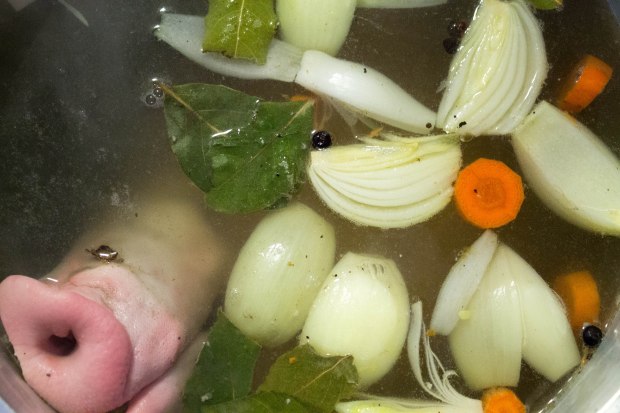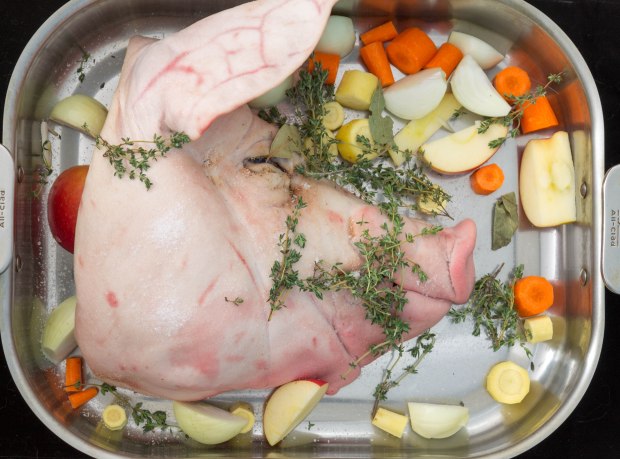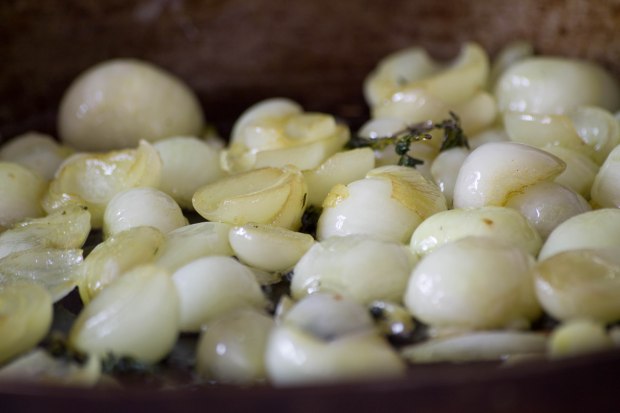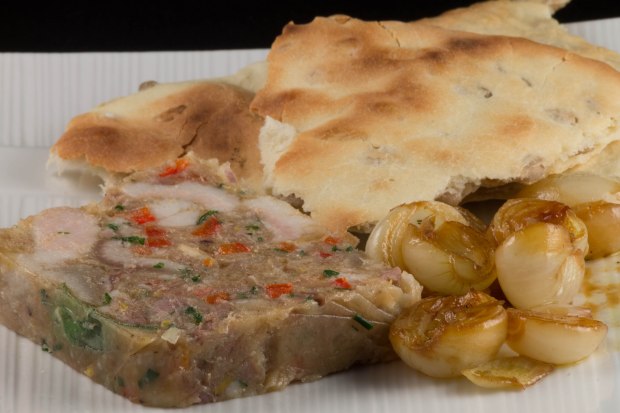Pork, red pepper, chives and lemon
Since first opening the Toqué! cookbook and looking through the recipes, I have really been looking forward to making this head cheese. One of the things I wanted to accomplish with this project was to learn how utilize ingredients we would not normally buy, cook with, or eat. A pig’s head certainly fits in this category!
We were able to get an incredibly fresh pig’s head (butchered that morning) from our favorite butcher at the local farmer’s market. We brought the head home and I thoroughly washed it. Thankfully, the butcher had recommended that the head be sliced in two, and it turned out even our largest pot at 18 quarts could only accommodate half of it.
To begin the cooking, half of the pig’s head was put into the pot, along with 7 liters of water, juniper berries, bay leaves, black pepper, carrots, onions, and a pig’s foot (at the recommendation of our butcher, who makes a lot of head cheese himself). The stock was then brought to a boil, and left to simmer for about 4 hours.
As making head cheese is a two day process, I needed to make myself dinner for that evening–so I put the second half of the head in a roasting pan with the same ingredients and spices as the stock, some maple syrup, what was left of the apple we used for photographing, and roasted in the oven for 7 hours on low heat until the skin was crispy and the meat was wonderfully soft and flavorful. That night, I sat down hungry with half of a pig’s head, a knife and a fork. The thing that really surprised me about the roasted dish was how many different textures of pork there were. The ear was so incredibly crispy, the cheek meat was fatty and stringy, the meat around the eyes was dark and soft, and the meat around the neck was very much like the regular roasted pork I’m used to.
After four hours of simmering, the meat and bones were strained out of the pot to cool, and I discovered first-hand how much of a time consuming process making head cheese really is! One of the skills I have been working on developing in the kitchen is patience. I have been known in the past to undercook meats, under-reduce sauces and even leave out components due to various reasons (usually hunger). I have since discovered that the secret to creating technically correct food is patience–unfortunately my patience is directly related to my hunger. Now I make sure I don’t cook hungry… and my food has been tasting much better as a result!
The strained pork head stock was successfully boiled down from 28 cups of liquid to 2 cups (a proud accomplishment for me) while skimming off the impurities as they arose. As the reducing process took quite a few hours, I had plenty of time to separate the pork into two piles: the parts I wanted to eat, and the bits I didn’t.
The resulting pork jus was then mixed with the select meat, some finely diced red peppers, chives, lemon zest, salt and pepper. I have some experience making cured meats, and have learned that when something is to be eaten cold, you must over season it while it’s still warm for the salt balance to be correct when it cools. I then poured the mixture into a terrine mould lined with plastic wrap, and left it in the fridge to solidify overnight.
The next day, we made some sautéed balsamic vinegar and thyme pearl onions with sunflower seed flatbread as accompaniments to complete the meal.
The head cheese was delicious: extremely fatty and flavorful. Along with the onions and flat bread, it made for a perfect lunch! One of the aspects of this project that I dislike is that most of these recipes that we try can only be attempted once due to the sheer volume of recipes we will be making for the blog. If I were to make this dish again, I would be more careful with lining the terrine with the plastic wrap to avoid ridges, and take the time to shred the pork into small pieces (as the recipe instructed). The pork jus with lemon was extremely flavorful, which made the large chunks of pork and fat seem a little bit bland by contrast–next time I’ll follow the recipe to a T!.






